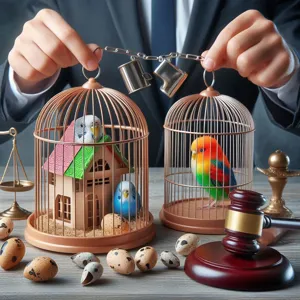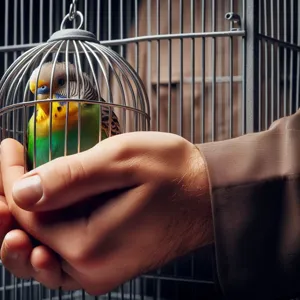The sight of colorful feathers and melodious chirps can bring joy to any home, but the question of whether caging pet birds is a humane practice or a necessary measure for their safety stirs up passionate opinions among bird lovers and animal rights advocates alike.
As companions who can bring life and vibrancy into our lives, birds also require a delicate balance of freedom and protection, leading to the great debate: is it cruel to confine these intelligent creatures within the confines of a cage, or is it essential for their well-being? In this thought-provoking blog post, we will explore the complexities surrounding bird ownership, examining the ethical considerations, the psychological needs of these avian friends, and the practices that can ensure they thrive in a home environment. Join us as we delve into the heart of this ongoing discussion, shedding light on the responsibilities of pet owners and the best ways to provide a fulfilling life for our feathered companions.
1. Introduction to the Debate: Caging Pet Birds

The debate surrounding the caging of pet birds is as vibrant and multifaceted as the birds themselves, sparking passionate discussions among pet owners, animal rights advocates, and avian enthusiasts alike. At the heart of this discourse lies a fundamental question: Is caging a bird an act of care and protection, or is it a form of confinement that undermines the animal’s well-being?
On one side, proponents argue that cages can provide a safe environment for pet birds, shielding them from potential dangers such as household pets, toxic plants, and other hazards. With proper size, enrichment, and care, cages can mimic natural habitats and allow birds to thrive in a domestic setting. Avian experts suggest that a well-designed cage can offer a haven where birds can exercise, play, and engage in natural behaviors, all while under the watchful eye of their dedicated owners.
Conversely, critics of caging assert that confining birds, even in spacious enclosures, deprives them of their inherent freedom and autonomy. Birds are inherently wild creatures, accustomed to soaring through expansive skies and exploring diverse environments. To keep them caged is to risk stifling their natural instincts and diminishing their quality of life. Many argue that the emotional and psychological impacts of confinement can lead to stress, boredom, and even health issues, raising ethical concerns about the implications of keeping birds in cages.
As we delve deeper into this debate, we will explore the perspectives of various stakeholders, examining the nuances of avian care and the responsibilities that come with pet ownership. By presenting both sides of the argument, we aim to foster a comprehensive understanding of this complex issue, ultimately encouraging more informed and compassionate decisions about the welfare of our feathered friends.
2. Understanding Bird Behavior in the Wild
Understanding bird behavior in the wild is essential for evaluating the ethics of caging pet birds. In their natural habitats, birds exhibit a remarkable array of behaviors that reflect their complex social structures, foraging habits, and instinctual needs. For instance, many species thrive in flocks, engaging in intricate social interactions that foster bonding and communication. Observing the vibrant cacophony of chirps and whistles as they navigate their environment is a testament to their social nature; these vocalizations serve not only as a means of communication but also as a way to establish hierarchies and find mates.
Foraging is another critical aspect of wild bird life. Birds spend a significant portion of their day searching for food, which can include seeds, fruits, insects, and small animals. This not only satisfies their nutritional needs but also stimulates their mental faculties, as they solve problems and navigate their territories. In contrast, pet birds often rely on their owners for a consistent food supply, which can lead to boredom and a lack of stimulation if their environment does not mimic the complexities of the wild.
Moreover, many species are migratory, traveling vast distances in search of suitable climates and nesting grounds. This instinctual drive to explore is often curtailed in captivity, where the confines of a cage limit their ability to roam and interact with their surroundings. Understanding these natural behaviors can illuminate the challenges faced by pet birds, as their instinctive needs for social interaction, mental stimulation, and physical activity may not be adequately met in a domestic setting.
Ultimately, by examining the behaviors of birds in the wild, we can gain insight into the ethical implications of caging them. It raises important questions about whether we can truly provide an environment that satisfies their intrinsic needs or if keeping birds in cages is an inherent cruelty that overlooks their complex social and behavioral requirements. This understanding can guide pet owners in creating a more enriching and fulfilling life for their avian companions, ensuring that the joys of bird ownership align more closely with the natural instincts of these beautiful creatures.
3. The Pros of Caging Pet Birds

When considering the debate around caging pet birds, it’s essential to acknowledge the potential benefits that come with providing a contained environment for these feathered companions. First and foremost, cages offer a safe haven from various household dangers. Birds, being naturally curious creatures, can easily get into trouble if left to roam freely. A well-designed cage protects them from hazards such as open windows, ceiling fans, and other pets, ensuring their safety and well-being.
Additionally, cages can serve as a secure space where birds feel comfortable and can retreat when feeling stressed or overwhelmed. Just like humans, birds need a sanctuary to rest and recharge, and a cage can provide that sense of security. Many birds will instinctively gravitate towards their cage, using it as a safe retreat when they want to feel sheltered.
Moreover, a properly maintained cage can facilitate a structured routine that mimics their natural behaviors. Caging allows for the establishment of feeding and playtimes, encouraging a healthy lifestyle. Owners can easily monitor their bird’s diet, ensure they are eating properly, and provide them with stimulating toys and activities to keep their minds engaged.
Cages also serve as a designated area for social interaction. By positioning the cage in a central location, owners can engage with their birds regularly, promoting bonding and companionship. This closeness can lead to happier, more social birds who thrive on the attention and interaction they receive from their human caregivers.
In essence, while the idea of caging birds brings with it an ethical debate, there are numerous advantages that, when approached thoughtfully, can contribute to the overall well-being of pet birds. As responsible pet owners, it’s crucial to create an enriching environment within the cage that allows for safety, comfort, and interaction, ensuring that our feathered friends lead fulfilling lives.
4. The Cons of Caging Pet Birds
When delving into the complexities of keeping pet birds, it’s essential to consider the potential downsides of caging them. Many bird enthusiasts argue that confinement can be detrimental to a bird’s physical and mental well-being. For starters, the natural habitat of birds is vast and open, allowing them to fly freely, forage, and engage in social interactions. In contrast, a cage, no matter how spacious, can feel restrictive and might lead to a range of behavioral issues, including stress, anxiety, and frustration.
One major concern is the lack of physical exercise that caged birds often experience. Birds are naturally inclined to fly long distances, and being confined to a limited space can result in obesity and other health problems. This sedentary lifestyle can also lead to stereotypic behaviors, such as excessive vocalization or feather plucking, as birds try to cope with the monotony of their environment.
Moreover, caging can inhibit a bird’s social instincts. Many species thrive in flocks and require social interaction to maintain their emotional health. Birds that are isolated in cages may become lonely and depressed, exhibiting signs of distress that can manifest in their overall demeanor. While owners may provide companionship, it often pales in comparison to the social dynamics found in the wild.
Another significant factor to consider is the potential for limited mental stimulation. Caged birds may not have access to the varied environments and experiences that their wild counterparts enjoy. This can stifle their natural curiosity and intelligence, leading to boredom and a lack of enrichment. To mitigate this, owners must be proactive in offering toys, puzzles, and regular out-of-cage time to provide their birds with mental challenges and opportunities for exploration.
In light of these concerns, many advocates for bird welfare emphasize the importance of creating an environment that closely resembles a bird’s natural habitat. This includes providing ample space, social interaction, and stimulation to ensure that pet birds can lead happy, fulfilling lives. It raises the question: can we truly provide a quality life for these intelligent creatures while keeping them confined, or should we seek alternatives that allow them to thrive in a more natural setting?
5. Physical and Psychological Impacts of Caging

When it comes to the physical and psychological impacts of caging pet birds, the debate intensifies. On one hand, proponents of caging argue that enclosures provide a safe environment, protecting birds from potential dangers such as predators, harsh weather, or accidents that could occur in an open setting. A well-designed cage can offer a secure space where birds can thrive, provided it is spacious enough to accommodate their need for movement and play.
However, the psychological implications of confinement cannot be overlooked. Birds are inherently social creatures, often accustomed to living in flocks. When caged, they can experience feelings of isolation, boredom, and frustration. The lack of stimulation in a small cage can lead to detrimental behaviors, such as feather plucking, excessive vocalization, or aggression. These behaviors are often signs of stress, indicating that the bird is not receiving the mental and emotional enrichment it needs to flourish.
Moreover, the physical health of caged birds can also be compromised. Without adequate space to fly or explore, they may suffer from obesity and related health issues. It’s essential for bird owners to recognize that while a cage can provide protection, it should never be a substitute for the bird’s natural instincts and behaviors.
To mitigate these impacts, bird owners should strive to create an enriching environment. This includes providing a cage that allows for movement, incorporating toys and perches of varying sizes, and ensuring regular out-of-cage time for exercise and social interaction. By understanding both the benefits and drawbacks of caging, bird owners can make informed decisions that prioritize the well-being of their feathered companions. Ultimately, the goal should be to strike a balance that respects a bird’s need for safety while also honoring its natural instincts for freedom and social connection.
6. Alternatives to Traditional Cages
As society evolves, so do our attitudes toward pet care, and the conversation surrounding bird caging is no exception. While traditional cages have long been the standard for housing pet birds, many owners are now exploring alternatives that prioritize the well-being and natural behaviors of these intelligent creatures.
One such alternative is the use of aviaries—spacious, open environments that mimic a bird’s natural habitat. These larger enclosures provide ample room for flying, climbing, and socializing, allowing birds to engage in behaviors that are often restricted in standard cages. Aviaries can be designed to include various perches, toys, and even plants, creating a stimulating environment where birds can thrive.
Additionally, free-flight rooms have gained popularity among bird enthusiasts. These designated areas within a home allow birds to roam freely in a safe environment, provided they are supervised. This setup not only gives birds the freedom to exercise their wings but also fosters a deeper bond between the owner and their feathered friends.
For those who prefer a more mobile option, play pens are an excellent choice. These portable enclosures can be set up in different areas of the home, allowing birds to experience new surroundings while still being contained. Playpens can be furnished with toys and foraging opportunities, ensuring that birds remain engaged and active.
Lastly, incorporating structured time outside of the cage into a bird’s daily routine is vital. Many bird owners find success in establishing a schedule that includes supervised out-of-cage time, where birds can interact with their environment, explore, and indulge their curiosity.
While traditional cages may provide a sense of security, considering these alternatives can enhance the quality of life for pet birds, ultimately leading to happier, healthier companions. As we continue to learn and adapt our practices, it’s crucial to prioritize the physical and psychological needs of our avian friends, ensuring they live fulfilling lives, whether they’re caged or free.
7. Setting Up an Enriching Environment

Creating an enriching environment for caged pet birds is a crucial aspect of their care that can significantly influence their quality of life. Many people mistakenly believe that a cage is merely a confinement tool, but it can also serve as a sanctuary for stimulation, safety, and comfort when designed thoughtfully. When setting up a birdcage, consider the various elements that contribute to a bird’s mental and physical well-being.
Start with the size and layout of the cage. A spacious cage allows birds to move freely, stretch their wings, and engage in natural behaviors. The placement of perches is equally vital; offer varying heights and widths to accommodate different activities, from resting to climbing. Natural wood perches provide texture and promote foot health, while swings and ladders can add an element of fun to their daily routine.
Next, introduce a variety of toys that cater to your bird’s species and personality. Birds are intelligent creatures that thrive on mental stimulation, and toys that challenge their problem-solving skills or promote foraging behaviors can be particularly beneficial. Rotate toys regularly to keep their environment fresh and engaging. Consider incorporating foraging opportunities into their daily routine, such as hiding treats within shredded paper or using puzzle feeders, which can mimic the search for food in the wild.
No birdcage is complete without a selection of natural branches, safe plants, and even items like cuttlebone or mineral blocks to encourage natural chewing behavior. These additions not only serve as enrichment but also promote healthy habits in your feathered friend.
Lastly, ensure that their environment includes a consistent routine of social interaction and outside-of-cage time. Birds are social animals that thrive on companionship, whether with their human caregivers or other birds. The combination of a well-structured cage environment and ample opportunities for social engagement can help alleviate the potential downsides of caging, making it a necessary aspect of responsible bird ownership rather than an act of cruelty. By thoughtfully setting up an enriching environment, you can create a haven where your pet bird feels secure, stimulated, and cherished.
8. Social Needs of Pet Birds
When considering the well-being of pet birds, one of the most critical aspects to address is their social needs. Birds, by nature, are highly social creatures. In the wild, they live in flocks, developing complex social structures and engaging in intricate relationships with their companions. This innate desire for social interaction doesn’t disappear when they are brought into our homes; rather, it morphs into a need for companionship, stimulation, and engagement.
Keeping a pet bird in isolation can lead to significant emotional distress and behavioral issues. A lonely bird may engage in destructive behaviors, such as feather plucking or incessant screaming, as they attempt to express their discomfort or boredom. Therefore, it’s essential for bird owners to recognize that these vibrant animals thrive when they have opportunities to socialize, whether with their human caregivers or with other birds.
To meet these social needs, consider adopting a pair of birds instead of a single one. This companionship can provide constant interaction and play, fulfilling their instinctual need for socialization. If having multiple birds isn’t an option, dedicating time each day to engage with your feathered friend is crucial. Interactive playtime, training sessions, and simply talking to your bird can help forge a strong bond, keeping them mentally stimulated and emotionally fulfilled.
Additionally, enriching their environment with toys, perches, and opportunities for exploration can further cater to their social instincts. Providing avenues for interaction, such as hanging mirrors or placing them in a room where they can observe family activities, can create a more fulfilling life for your pet bird. Ultimately, understanding and addressing the social needs of pet birds is not just beneficial—it’s necessary for their happiness and well-being. By fostering an environment where your bird can thrive socially, you’ll ensure a happier and healthier pet, bridging the gap between their wild instincts and domestic life.
9. The Role of Ownership Responsibilities
When it comes to the complex issue of caging pet birds, ownership responsibilities play a pivotal role in determining the well-being of these vibrant creatures. Bird ownership is not merely about providing a home; it’s about creating an environment that nurtures their physical and psychological health. Understanding the specific needs of your bird species is essential. Some birds thrive in larger spaces, while others may feel secure in smaller, well-structured cages.
As a bird owner, it is your responsibility to ensure that the cage you provide is not just a confinement but a sanctuary. This means selecting the right size and type of cage, which allows for adequate space to stretch their wings, climb, and explore. Additionally, the cage should be equipped with enriching toys, perches of varying sizes, and safe, stimulating activities to keep your feathered friend engaged and happy. The importance of a diverse diet and regular out-of-cage time cannot be overstated; these are essential for the bird’s physical health and emotional well-being.
Moreover, it’s crucial to recognize the social nature of birds. Many species are inherently flock animals, meaning they thrive on interaction—both with their human companions and potentially with other birds. Therefore, it’s your duty to provide opportunities for socialization, whether through daily playtime, training, or, if appropriate, companionship with other birds.
Ultimately, the debate over whether caging pet birds is cruel or necessary hinges on the level of commitment and understanding an owner brings to the relationship. Responsible ownership means prioritizing the needs of your bird, ensuring that at every stage, their safety, happiness, and health are at the forefront of your care practices. By investing time, effort, and resources into creating an enriching environment, you can help bridge the gap between necessity and cruelty, fostering a fulfilling life for your pet bird within the constraints of captivity.
10. Case Studies: Different Bird Species and Their Needs
When it comes to understanding the complexities surrounding the debate on caging pet birds, it’s essential to consider the unique needs of different species. Each bird has its own set of requirements that stem from its natural habitat, social structure, and behavioral instincts. By examining case studies of various bird species, we can shed light on the nuances of their care and the implications of confinement.
**1. Parakeets (Budgerigars)**
Parakeets, commonly known as budgies, are one of the most popular pet birds. In the wild, they thrive in large flocks, flying long distances in search of food and companionship. This inherent social behavior means that budgies can become lonely and stressed if kept in isolation. Case studies show that providing a spacious cage with plenty of toys, perches, and opportunities for social interaction—either with humans or other birds—can significantly enhance their well-being. Ensuring that they receive ample out-of-cage time for flight and exploration is equally crucial. When their social needs are met, parakeets can flourish in captivity, proving that a well-enriched environment can mitigate the potential cruelty of caging.
**2. Cockatoos**
Known for their intelligence and strong personalities, cockatoos require not just physical space but also mental stimulation. In the wild, these birds engage in complex social interactions and problem-solving activities. Unfortunately, many cockatoos in captivity suffer from behavioral issues such as feather plucking and excessive vocalization when their needs are not met. Case studies highlight the importance of environmental enrichment—such as puzzle toys, foraging activities, and social engagement—to keep them happy and healthy. A cage that is too small or devoid of stimulation can lead to frustration and anxiety, raising ethical questions about the practice of caging these vibrant creatures.
**3. Canaries and Finches**
While canaries and finches are often regarded as lower-maintenance pets, they too have specific needs that must be addressed. These small birds thrive in pairs or small groups, as they are naturally social creatures. Research indicates that while they can be kept in cages, having a larger aviary-like setup can promote better health and happiness. Case studies reveal that canaries, when housed in spacious aviaries with appropriate companions, display more natural behaviors, such as singing and socializing. Conversely, solitary confinement can lead to stress and a lack of vitality, underscoring the necessity of considering species-specific social structures when discussing the ethics of caging.
**4. African Grey Parrots**
African Grey Parrots are renowned for their exceptional intelligence and ability to mimic human speech. In the wild, they form strong bonds and live in complex social groups. The case studies conducted on these parrots illustrate the dire consequences of inadequate social interaction and mental stimulation. Birds housed in small cages without sufficient enrichment often exhibit signs of distress, leading to a debate on whether keeping them caged, even with ample toys, is ethical. This highlights the importance of not only providing a spacious cage but also ensuring that these birds have frequent and meaningful interaction to satisfy their social and cognitive needs.
In conclusion, the debate surrounding caging pet birds cannot be resolved with a one-size-fits-all approach. A thorough understanding of the specific needs of each bird species is essential to ensure their well-being. While some birds may adapt well to life in a cage when provided with the right environment and social interactions, others may suffer from confinement’s limitations. By analyzing case studies
11. Expert Opinions: Veterinarians and Animal Behaviorists
When it comes to understanding the complexities of caging pet birds, expert opinions from veterinarians and animal behaviorists offer invaluable insights. These professionals bring a wealth of knowledge regarding avian health, welfare, and behavior, making their perspectives essential to the ongoing debate.
Veterinarians often emphasize the physiological and psychological needs of birds, highlighting that proper care requires more than just a safe cage. They argue that while cages can provide a secure environment, they must be appropriately sized and enriched to promote physical health and emotional well-being. A small, barren cage can lead to stress, anxiety, and even physical ailments like feather plucking or obesity. In contrast, a spacious cage equipped with toys, perches, and opportunities for social interaction can help birds thrive, mimicking their natural habitats to some extent.
On the other hand, animal behaviorists focus on the social and cognitive aspects of bird behavior. They advocate for acknowledging the intelligent and highly social nature of many bird species. According to their research, many birds experience a range of emotions and require mental stimulation to remain happy and healthy. This means that simply providing a cage is not enough; birds need out-of-cage time, opportunities to explore, and interactions with their owners or other birds.
Both veterinarians and animal behaviorists agree that responsible pet ownership involves a commitment to understanding and meeting these needs, advocating for a balanced approach that considers the bird’s quality of life. Their collective insights highlight that while caging pet birds can serve a necessary purpose for safety and containment, it must be done thoughtfully, ensuring that the cage environment enriches rather than confines. By creating a suitable habitat and providing ample opportunities for socialization and exploration, pet owners can bridge the gap between the necessity of caging and the well-being of their feathered companions.
12. The Importance of Education for Bird Owners
**12. The Importance of Education for Bird Owners**
In the ongoing debate about caging pet birds, one aspect that often gets overlooked is the vital role education plays in responsible bird ownership. Many potential bird owners enter the realm of avian companionship with limited knowledge about their feathered friends’ needs, behaviors, and the intricacies of their care. This gap in understanding can lead to misguided practices that may unintentionally compromise the well-being of these sensitive creatures.
Education is essential for bird owners to create a nurturing environment that mimics their natural habitats as closely as possible. For instance, understanding the social nature of many bird species can inform owners about the importance of companionship—whether that means adopting multiple birds or providing ample interaction and stimulation through toys and socialization. Knowledge about dietary requirements, environmental enrichment, and the specific needs of different species can also significantly impact a bird’s physical and mental health.
Moreover, an educated owner is more likely to recognize signs of stress or illness in their birds, leading to timely veterinary care and preventive measures. Workshops, online courses, and community resources can equip bird owners with the necessary skills and insights to foster a more enriching environment.
By prioritizing education, bird owners can transcend the debate of whether caging is cruel or necessary. Instead, they can focus on how to provide the best possible care for their avian companions, ensuring their homes are not just cages, but sanctuaries of safety, love, and stimulation. Ultimately, informed decisions lead to happier, healthier birds and a more rewarding experience for both owners and their cherished pets.
13. Balancing Freedom and Safety for Pet Birds
When it comes to the debate over caging pet birds, a critical consideration is finding a balance between freedom and safety. Birds are inherently wild creatures, accustomed to flying freely in their natural habitats. They thrive on exploration, stimulation, and social interaction. However, the reality of keeping pet birds requires us to address their safety needs, which often necessitates restrictions on their freedom.
Caging is often viewed as a necessary practice to protect birds from potential dangers found within our homes, such as toxic plants, harmful chemicals, and open windows. A properly designed cage provides a secure environment where birds can feel safe from predators and hazards. Additionally, it offers a designated space for meals, rest, and enrichment activities, which are essential for their well-being.
However, it’s crucial that we don’t view cages as mere containment units. Instead, they should be seen as a part of a more extensive system that promotes a bird’s physical and mental health. Larger cages with adequate space for movement, coupled with daily out-of-cage time, can help satisfy a bird’s natural instinct to explore and exercise.
Moreover, enriching a bird’s environment, whether inside the cage or outside, is essential. Providing toys, perches at varying heights, and opportunities for social interaction can help mimic a more natural setting. Creating a structured routine that includes flying, playtime, and interaction can also enhance their lives, making the cage feel more like a safe haven rather than a prison.
Ultimately, the goal should be to create a harmonious environment that prioritizes the bird’s safety while also respecting its need for freedom. By thoughtfully considering how we house and engage with our feathered companions, we can foster a rewarding relationship that honors their instincts and needs. In this delicate balance, caging can be both a protective measure and a tool for nurturing a fulfilling life for pet birds.
14. Conclusion: Finding a Middle Ground
In the ongoing debate surrounding the ethics of caging pet birds, it becomes evident that a nuanced perspective is essential to navigate the complexities of avian care. While some may argue that confinement inherently restricts a bird’s natural behaviors and undermines its well-being, others highlight the protective benefits of caging—offering safety from predators, environmental hazards, and the chaos of a human household.
Ultimately, the conclusion is not a black-and-white matter but rather a call to find a middle ground that honors the needs of pet birds while respecting the realities of pet ownership. Creating an enriched environment within the cage is paramount; this can include ample space for movement, interactive toys, and opportunities for mental stimulation. Additionally, regular out-of-cage time in a safe, supervised setting can significantly enhance a bird’s quality of life, allowing it to explore and express itself in a manner that mimics its natural behaviors.
Moreover, educating potential bird owners about the specific needs of different species can foster a deeper understanding of their care requirements, ensuring that the decision to cage a bird is made with compassion and awareness. Both pet owners and advocates for avian welfare can work together to promote practices that prioritize the happiness and health of these extraordinary creatures. In this synthesis of perspectives, we can find a compassionate approach that respects both the instincts of our feathered friends and the realities of their domesticated lives.
15. Resources for Bird Owners: Best Practices and Guidelines
When it comes to caring for pet birds, knowledge is key. Understanding their needs, behaviors, and the best practices for their well-being can mean the difference between a thriving, happy companion and a stressed, unhappy one. For both seasoned bird owners and those considering adding a feathered friend to their family, a wealth of resources is available to guide you in providing the best possible care.
One of the most reliable resources is the American Bird Conservancy, which offers comprehensive guidelines on bird care, including habitat enrichment, diet, and health monitoring. Their educational materials are designed to help owners understand the social, physical, and emotional needs of their birds. From choosing the right cage to recognizing signs of stress or illness, their insights are invaluable.
Additionally, local avian veterinarians can be an excellent source of personalized advice. Many vet clinics specialize in exotic pets and can provide tailored recommendations based on your bird’s species and individual health needs. Regular check-ups can help catch potential health issues early, ensuring your pet remains healthy and happy.
Books such as “The Bird Care Book: The Complete Guide to Caring for Pet Birds” by Michael S. McCauley also offer a wealth of information. This guide covers everything from basic anatomy and behavior to advanced topics like avian first aid and emergency care. It’s an excellent starting point for new bird owners seeking to deepen their understanding of their pets.
Online communities and forums, such as those on Reddit and Facebook, can also be supportive spaces for bird owners. Here, you can exchange tips, share experiences, and ask questions in a welcoming environment. Connecting with fellow bird enthusiasts often leads to discovering new practices and resources that can enhance your bird-keeping experience.
Incorporating these resources into your routine will not only help you nurture a loving relationship with your pet bird but will also ensure you are equipped with the right knowledge to provide the best care possible. By staying informed and proactive, you contribute to a fulfilling life for your feathered friend—one that respects their natural instincts while adapting to the comforts of domestication.
As we wrap up this exploration of the great debate surrounding the caging of pet birds, it’s clear that this topic evokes strong emotions on both sides. While some argue that cages limit birds’ natural behaviors and can lead to physical and psychological distress, others believe that properly designed enclosures provide a safe haven, protecting these delicate creatures from environmental hazards and potential predators. Ultimately, the key lies in understanding the needs of individual birds and committing to providing an enriching, spacious, and stimulating environment, whether in a cage or an aviary. We encourage you to reflect on the insights shared in this article and engage in thoughtful discussions about the best ways to care for our feathered friends. Together, we can ensure that the companionship of pet birds is rooted in love, respect, and a commitment to their well-being.






